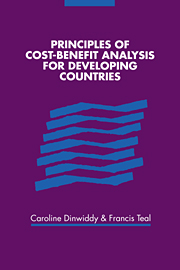Book contents
- Frontmatter
- Contents
- List of figures
- List of economic models and tables
- Preface
- Part I: Introduction to welfare economics
- Part II: Project and policy appraisal in developing countries
- 5 Project appraisal: an overview
- 6 Shadow prices for traded and non-traded commodities in an open economy
- 7 Trade policy, exchange rates and structural adjustment
- 8 Labour markets in developing countries
- 9 The social value of labour
- 10 Intertemporal costs and benefits (1): a market-based approach
- 11 Intertemporal costs and benefits (2): a social planning approach
- Part III: Missing markets
- Retrospect
- Bibliography
- Index
7 - Trade policy, exchange rates and structural adjustment
Published online by Cambridge University Press: 22 October 2009
- Frontmatter
- Contents
- List of figures
- List of economic models and tables
- Preface
- Part I: Introduction to welfare economics
- Part II: Project and policy appraisal in developing countries
- 5 Project appraisal: an overview
- 6 Shadow prices for traded and non-traded commodities in an open economy
- 7 Trade policy, exchange rates and structural adjustment
- 8 Labour markets in developing countries
- 9 The social value of labour
- 10 Intertemporal costs and benefits (1): a market-based approach
- 11 Intertemporal costs and benefits (2): a social planning approach
- Part III: Missing markets
- Retrospect
- Bibliography
- Index
Summary
This chapter continues our discussion of cost-benefit analysis in an open economy. In chapter 6, we considered welfare aspects of public sector production activities, and the analysis focused on the choice of appropriate shadow prices for commodity inputs and outputs in a tax-distorted economy. In this chapter, we turn our attention to the welfare consequences of policies which act directly to alter relative prices – in particular, those policies which are linked in one way or another with a country's exchange rate.
In the real general equilibrium models of chapter 6 it was assumed that the exchange rate was just one of the relative prices of the system, determined by the structure of production and the demand for traded commodities. In the solution to these models, it was assumed that all commodity and factor markets and the balance of payments would arrive at a market-clearing equilibrium. This market-clearing model is clearly at variance with the observed facts about many developing countries where balance of payments problems and, by implication, a ‘shortage’ of foreign exchange lead to difficulties with the exchange rate. In many less developed countries there is extensive intervention in the foreign exchange markets so that multiple exchange rates exist – either at a formal level with different transactions taking place at different official rates and/or at an informal (frequently illegal) level with high ‘black-market’ rates co-existing with the official rate.
- Type
- Chapter
- Information
- Principles of Cost-Benefit Analysis for Developing Countries , pp. 117 - 136Publisher: Cambridge University PressPrint publication year: 1996



